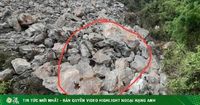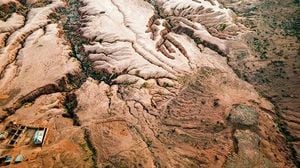The early morning of August 20, 2025, in Tân Thanh commune, Ninh Bình province, began like any other for Mrs. Trần Thị Vân. At around 5:00 AM, she set out from her modest home in Đồng Ao village, carrying a simple bag and heading toward Bắt Ốc mountain, about five kilometers away. For years, she had eked out a living by picking mountain snails, a solitary occupation that demanded both resilience and an intimate knowledge of the rugged local terrain. But this day would end differently—and tragically—for Mrs. Vân and her close-knit rural community.
By 6:00 PM that evening, concern began to ripple through the village. Mrs. Vân had not returned, and her absence was deeply felt. According to Dân trí, her younger brother and sister-in-law, noticing she hadn’t come home, immediately began searching for her. When their efforts yielded no sign, they notified local authorities. The village quickly mobilized, and a search party was formed, comprising local police, self-defense forces, security guards, and dozens of concerned villagers. The sense of urgency was palpable; everyone knew that the mountainous landscape could be unforgiving, especially as night fell and temperatures dropped.
According to Tiền Phong, the searchers faced a daunting task. Bắt Ốc mountain is notorious for its steep, jagged limestone cliffs, dense vegetation, and labyrinthine caves. The area is vast, and many spots are rarely visited. Communication was another hurdle—mobile signals were patchy or nonexistent, making coordination among search teams a challenge. “The mountains are endless, so the search is not easy at all. Still, we told each other we must try our best,” one member of the search party told Tiền Phong. To sustain themselves, villagers packed bread, milk, and water, bracing for long hours combing the perilous slopes.
Mrs. Vân’s daily routine was well known to her neighbors. She would often leave at dawn, armed with little more than her snail bag, and return by late afternoon. On this fateful day, however, she had left her mobile phone at home, a detail that, in hindsight, complicated the search efforts significantly. From the outset, the authorities and family members scoured the suspected routes, even checking surveillance cameras along the roads leading to the mountain, but no useful clues emerged in those early hours.
As the search stretched into its second and third days, anxiety in the village mounted. By the evening of August 22, 2025, as reported by Tiền Phong, there was still no trace of Mrs. Vân. The terrain was not only physically challenging but also mentally taxing for the searchers. Many were local volunteers, some of whom had known Mrs. Vân for years. The possibility that she had suffered an accident or worse weighed heavily on everyone’s minds. The search teams pressed on, driven by a mix of hope, duty, and community spirit.
It was in the early hours of August 23, after three grueling days, that the search finally came to a somber conclusion. According to official confirmation from Tân Thanh commune authorities, Mrs. Vân’s body was found beneath a layer of rocks in a remote, high-altitude area near the mountain’s peak. The location was particularly treacherous—characterized by steep, sharp rocks and thick foliage, and rarely traversed by locals or visitors. Only a handful of the most experienced searchers could reach the spot, and retrieving her body proved to be a difficult and delicate operation.
“After many search efforts, a member of the search team discovered the location of Mrs. Vân at dawn,” reported Dân trí. She was already deceased when found. The authorities immediately began organizing the return of her body to her family, while also launching an investigation to determine the precise cause of her death. As of the latest updates, the official cause remains under review, with police and other agencies handling the case with the utmost care and attention.
Mrs. Vân’s story is, in many ways, a reflection of rural life in parts of northern Vietnam. Living alone, without a husband or children, she had long relied on the demanding but honest work of snail picking. The job required her to venture into the mountains almost daily, navigating dangerous terrain for hours at a time. Her disappearance—and the community’s response—highlight the precarious nature of such livelihoods and the deep interdependence among villagers in these close communities.
The news of her death sent shockwaves through Đồng Ao and the surrounding areas. For three days, hope had mingled with dread as searchers combed the mountainside, calling out her name and checking every possible hiding spot. The villagers’ willingness to endure hardship—packing food, braving the elements, and working together—spoke volumes about the bonds that tie these communities together. “We told each other we must try our best,” repeated one search team member, a simple but profound testament to their determination and care for one another.
Throughout the ordeal, the challenges posed by the mountainous terrain were ever-present. The searchers had to contend with not only the physical obstacles—steep rocks, dense undergrowth, and caves—but also the lack of technological support. With limited phone service, organizing the search required old-fashioned methods: word of mouth, coordinated meeting points, and a lot of perseverance. These difficulties underscore the broader challenges facing rural emergency response in remote areas, where modern conveniences can be scarce and every minute counts in a crisis.
As the investigation into Mrs. Vân’s death continues, the community is left to mourn a woman who, though she lived alone, was far from forgotten. Her passing has prompted reflection on the dangers faced by those who work in such hazardous environments and the importance of community solidarity in times of trouble. Authorities remain committed to uncovering the circumstances that led to her tragic end, while villagers rally around her family, offering support and comfort in the days ahead.
For now, the mountains of Ninh Bình are quiet again, but the memory of Mrs. Vân and the collective effort to bring her home will linger—a poignant reminder of resilience, loss, and the enduring strength of community.





